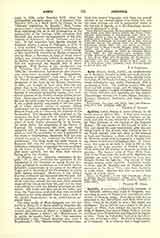

Agricius, Saint, Bishop of Trier (Treves), in the fourth century (332 or 335). A local ninth-century tradition states that he had been Patriarch of Antioch, and that he was translated to the See of Trier by Pope Silvester, at the request of the Empress Helena. He was present at the Council of Arles in 314, and signed the acts immediately after the presiding bishop of that diocese, thus indicating that in the fourth century Trier laid claim to the primacy of Gaul and Germany, a claim which his successor, St. Maximin, made good by signing in a similar way the Decree of the Council of Sardica (343). St. Athanasius, who came as an exile to Trier in 335 or 336, speaks of the large numbers of faithful whom he found there and the number of churches in course of erection. The famous relics of Trier (Holy Coat, Nail of the True Cross, the body of St. Matthias the Apostle) are said by local tradition to have been brought thither by Agricius. The schools of Trier became famous under Agricius. Lactantius taught in them, and St. Maximin and St. Paulinus, later successors to the See of Trier, came from Aquitaine to study there. Agricius died after an active episcopate of twenty years.
FRANCIS W. GREY

